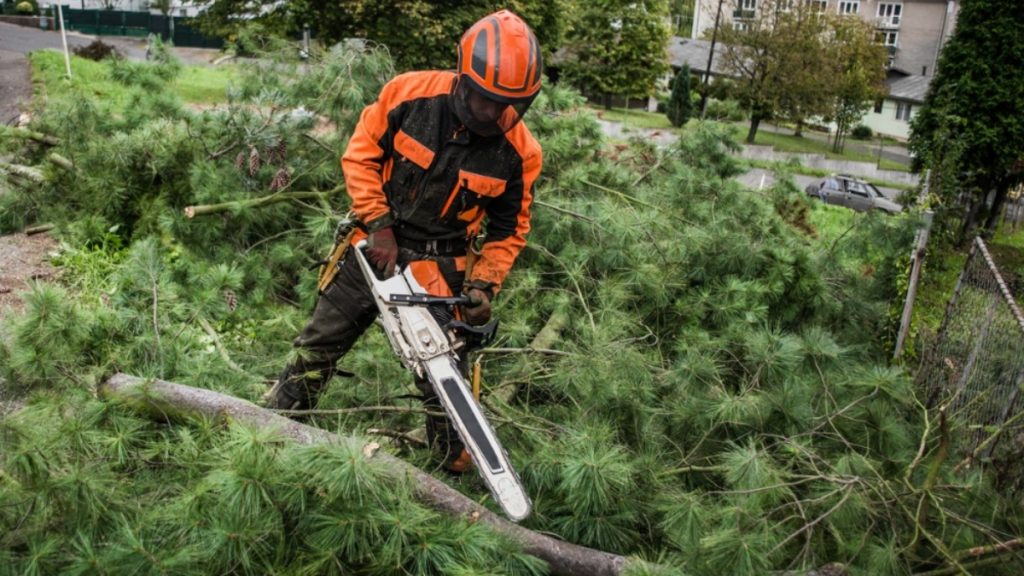When working with chainsaws, safety is paramount. A well-chosen helmet can be the difference between a minor mishap and a serious injury, especially considering the potential dangers of flying debris, falling branches, and the chainsaw itself. In this guide, we’ll explore what makes a good helmet, the features to consider, and the importance of proper maintenance to ensure the highest level of protection.
Chainsaw helmets are an essential component of Personal Protective Equipment (PPE) and are required by most safety regulations for those operating chainsaws professionally or in high-risk environments. These helmets provide critical protection not only against head injuries but also against other risks associated with chainsaw work, such as hearing damage and eye injuries. While each helmet component serves a different purpose, they are designed to work together as an integrated system that ensures comprehensive protection.
At a minimum, a chainsaw helmet should provide:
- Impact Resistance: To protect from falling branches and other impacts.
- Face Protection: A shield to guard against wood chips and flying debris.
- Hearing Protection: Ear muffs or plugs to reduce the risk of hearing loss due to chainsaw noise.
When selecting a helmet for chainsaw use, it’s always good practice to buy from a reputable source. Trusted brands, like Garden Machinery Direct, often offer superior quality, and their helmets are more likely to meet high safety standards and provide better warranties. There are several features and specifications to consider:
- Material and Durability
The outer shell of a chainsaw helmet is typically made from high-density polyethylene (HDPE) or polycarbonate. Both materials are highly resistant to impact, ensuring they can withstand hits from branches or falls. However, some high-end helmets are made with advanced materials, like ABS plastic or composite blends, which may provide greater durability or be more lightweight. Lightweight materials are preferable for comfort, especially for prolonged use, but they must still meet impact resistance standards.
- Integrated Face Shield
Chainsaw helmets often come with built-in face shields. Mesh face shields are common as they allow visibility and airflow, reducing the likelihood of fogging up. However, polycarbonate face shields provide a higher level of protection against fine debris and liquid sprays. In some cases, helmets come with interchangeable shields, allowing workers to switch based on the task and environment.
- Hearing Protection
Chainsaws generate noise levels that can exceed 110 decibels, a level that can lead to permanent hearing loss with prolonged exposure. High-quality chainsaw helmets will include ear muffs with adequate noise reduction ratings (NRR), usually rated around 22-30 decibels. Some helmets offer ear protection that swivels or can be moved away from the ear when not needed, adding convenience and adaptability for different tasks.
- Adjustable Suspension System
A good helmet should fit comfortably and securely on the user’s head. Suspension systems inside the helmet often have adjustment points, enabling users to customize the fit. Look for helmets with ratchet-style adjustments, as they offer precise fit adjustments even while wearing gloves. Additionally, suspension systems with cushioned or sweat-absorbing materials improve comfort for long periods.
- Ventilation
Working with a chainsaw is physically demanding, and overheating can become a serious issue, especially in warm weather. Some chainsaw helmets include venting options that allow air to circulate, helping to keep the wearer cool. These vents should be designed to maintain safety standards while providing comfort.
- High-Visibility Colors and Reflective Strips
Many chainsaw helmets are designed in bright colors like orange or yellow to improve visibility, which is essential for logging or forestry work where operators are often in dense woods or areas with poor visibility. Reflective strips on helmets can further enhance visibility, especially in low-light conditions or at dusk.
Helmet Standards and Certifications
Chainsaw helmets should comply with relevant safety standards, such as:
- EN 397: A European standard covering impact resistance and other performance factors for industrial safety helmets.
- ANSI Z89.1: An American standard that specifies performance requirements for protective headgear, including impact resistance and electrical insulation.
- EN 1731: For mesh eye and face protectors used in forest work.
These certifications indicate that the helmet has been tested and meets minimum safety requirements. Always look for these marks on the helmet or in its documentation.
Maintenance and Inspection of Chainsaw Helmets
A chainsaw helmet’s protective capabilities can degrade over time due to wear, UV exposure, or accidental impacts. Here are some maintenance tips to extend the helmet’s life and ensure it continues to offer adequate protection:
- Regular Inspection: Check for cracks, dents, or any signs of wear on the helmet’s shell. Even minor cracks can compromise the helmet’s structural integrity.
- Replace Worn Parts: Over time, components like the suspension system, face shield, or ear muffs may wear out. Many helmets allow for replacement parts, which is a cost-effective way to maintain safety standards.
- Clean Properly: Avoid using harsh chemicals when cleaning. Instead, use mild soap and water to remove dirt and sweat, especially from the suspension system and ear muffs.
- Replace the Helmet as Recommended: Helmets should typically be replaced every 3 to 5 years or after a significant impact, even if there is no visible damage. Most manufacturers provide a lifespan guideline for their helmets, which is essential to follow.




